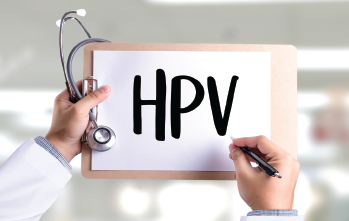
© one photo / shutterstock.com
Your patient has oropharyngeal cancer, and it’s linked to human papillomavirus (HPV). The good news: You get to tell them this is the most highly treatable of oropharyngeal cancers, and their prognosis is excellent. The bad news: Talking to patients and their loved ones about conditions that may have been sexually transmitted can be awkward for you and upsetting to them.
Explore This Issue
October 2019“Physicians should use sensitivity when talking to patients about HPV, recognizing that there may be shame and embarrassment about discussing a sexually transmitted disease,” said Marilene B. Wang, MD, professor in the department of head and neck surgery at the David Geffen School of Medicine at the University of California at Los Angeles.
Sometimes delivering the news can be tricky. Milan Amin, MD, professor of otolaryngology-head and neck surgery and director of the New York University Langone Voice Center, once had a male patient in his 70s who developed HPV-linked benign papilloma lesions in the larynx, a diagnosis that created trouble at home. “He and his wife had an argument about the whole thing and called us to help settle it,” Dr. Amin said. “She wanted to know how he got this and whether it was from cheating on her.” The couple’s minds were put at ease when Dr. Amin explained that the HPV virus can lie dormant in the body for years and then reactivate. And, according to the Centers for Disease Control, in some cases it can even take decades to cause oropharyngeal cancer. “I told her it’s not that this shows he went outside the marriage,” he said. “It’s most likely that both of them have HPV and that somehow there may be this cycle of infection and re-infection occurring and somehow his immune system stopped suppressing the virus and it was able to grow.”
Early in her practice, when she was just learning about HPV and its role in oropharyngeal cancer, Yelizaveta (Lisa) Shnayder, MD, professor of otolaryngology-head and neck surgery at the University of Kansas School of Medicine in Kansas City and co-director of the Fellowship in Head and Neck Oncology and Microvascular Reconstruction, had a patient with HPV-
related cancer of the tongue base. The evening after she gave him the biopsy results, he discussed them with his wife of 40 years, and she admitted a very distant past infidelity. The patient disclosed this to Dr. Shnayder at a subsequent visit, and she wasn’t sure how to react. She told the patient that it was unclear how he came to be infected by HPV. “The patient, however, felt that he and his wife had worked through this and reconciled and became stronger as a couple,” she added. “This situation made me realize how sensitive this discussion of HPV-caused cancers can be.”
It’s not just HPV that may bring on these potentially uncomfortable discussions. Several diseases that present with lesions in the ears, nose, throat, and mouth are—or may be—sexually transmitted. These may include HIV, labial and genital herpes virus infections, and oral or genital papillomas from low-risk HPV types, said Dr. Shnayder. There is also new research showing an association between hepatitis-C and cancers of the head and neck.
In Dr. Shnayder’s practice, she occasionally sees patients with abnormal lymph nodes or oral lesions or cysts in the parotid glands who have HIV. She also sees oral and nasal papillomas (low-risk HPV subtypes 6 and 11) caused by the HPV virus, as well as the high-risk HPV subtypes 16 and 18, which are often implicated in oropharyngeal and cervical cancers.
When two people are in a monogamous relationship for many years, it is impossible to know which person transmitted the original infection. —Lisa Shnayder, MD
Ask Family Members to Step Outside
Usually, when patients are diagnosed with these conditions, physicians bring up the subject of sexual transmission and how to prevent the spread of these contagious diseases. Dr. Shnayder said that, very often, her patients with cancer bring their families to their first consultation and may bring it up themselves when others are in the room. “When the conversation turns to the HPV-related infection and modes of transmission and what this means for the patient’s spouse, I usually politely ask the family members other than the patient’s spouse to step outside the room,” she said. Dr. Shnayder believes it’s important to have the patient’s partner present so they can discuss cervical cancer screenings, if the partner is a woman. She personally brings other family members back to the room when the conversation returns to discussing prognosis and treatment options.
Dr. Wang adds that a patient may be especially concerned about their partner’s reaction and potential risk, so it’s important for the physician to provide this information to both.
How to Break the News about HPV
When it comes to HPV-related oropharyngeal cancer, Dr. Shnayder tells patients that the virus is transmitted via sexual contact, but she doesn’t dwell too much on that part. “When two people are in a monogamous relationship for many years, it is impossible to know which person transmitted the original infection,” she said. “We need to focus on treating and recovering from this cancer, knowing that prognosis is better for HPV-caused tumors. We also need to focus on vaccinating family members within the age range of vaccination recommendation, to spare them from ever contracting this cancer.”
Dr. Wang tells patients that almost all sexually active adults will come in contact with this virus, and that when a patient is diagnosed with an HPV-positive cancer, it does not mean that they or their partner have been promiscuous, or that their partner is necessarily at risk of developing cancer. She recommends that the usual screening guidelines for oral and cervical cancer continue to be followed and that the patient see their physicians regularly.
And Dr. Amin explains to patients that approximately 95% of adults in the U.S. are circulating antibodies to HPV. “The immune system clears the virus, but in that cycle of exposure, clearance, and re-exposure, sometimes with the benign papillomas, patients develop an immune tolerance that allows the virus to propagate and create disease,” he said. “We don’t know if this happens in cancer, but it’s assumed it’s the same mechanism.”
As movie and television stars such as Michael Douglas and Marcia Cross have been forthright about their HPV-linked cancers, there is less of a stigma attached to talking about these conditions. “Patients are much more aware now because it’s being covered on the news,” Dr. Shnayder said. And because the incidence of HPV is on the rise, she added, it’s much more common now to have these discussions with patients than it was even five years ago. “I predict until we catch up with vaccinations we are going to see more patients over the next 10 years.”
Renée Bacher is a freelance medical writer based in Louisiana.
HPV-Linked Cancers Becoming More Common in Young People
According to the American Cancer Society, in the past few decades there has been a dramatic rise in oropharyngeal cancers linked to HPV, and these cancers are becoming more common in younger people with no history of tobacco or alcohol abuse. While the cause of the rising rate of HPV-linked cancers is unclear, some believe it may be due to an increase in oral sex in recent decades.
New Research on Hepatitis C and Its Association with HN Cancers
Researchers at The University of Texas MD Anderson Cancer Center in Houston noticed high rates of hepatitis C virus (HCV) infection in their patients with head and neck cancers and launched several studies that confirmed the association (Cancer. 2018;124:960-965; J Natl Cancer Inst. 2016;108. doi: 10.1093/jnci/djw035). The virus, spread through direct contact with blood and other bodily fluids, can be spread by sharing needles as well as sexual transmission. These findings may change HCV screening practices and treatment in patients with cancer.
